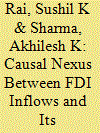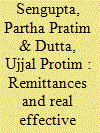|
|
|
Sort Order |
|
|
|
Items / Page
|
|
|
|
|
|
|
| Srl | Item |
| 1 |
ID:
175348


|
|
|
|
|
| Summary/Abstract |
This article aims to understand the drivers of foreign direct investment (FDI) inflows and its nexus with its determinants such as economic growth, inflation rate, labour productivity, infrastructure development, market size, openness of the economy, political stability and corporate tax for South Asian Association for Regional Corporation (SAARC) countries. The article is based on secondary data from the World Bank and International Labour Organization (ILO) for 19 years from 2001 to 2018 for 6 SAARC countries, viz. Bangladesh, Bhutan, India, Nepal, Pakistan and Sri Lanka. The findings indicate that there exists long-run, short-run and joint causal relationship among infrastructure development, market size, openness of the economy, political stability and corporate tax and FDI inflows. Among these variables, the corporate tax is the most important one because it shows bidirectional causality with FDI inflows in the long run as well as short run along with joint strong causality. However, only the coefficients of infrastructure development and corporate tax were found to be positively and negatively significant, respectively. Therefore, better infrastructure development and decrease in corporate tax may enhance FDI inflows in SAARC countries. This infers that with the decrease in corporate tax, more FDI inflows may take place, and higher FDI inflows may decrease in corporate tax further. Therefore, this article suggests that SAARC countries should accelerate the process of integration of their economy with the rest of the world along with political stability, enhance the infrastructure facility and reduce the corporate tax to get the higher FDI inflows.
|
|
|
|
|
|
|
|
|
|
|
|
|
|
|
|
| 2 |
ID:
136063


|
|
|
|
|
| Summary/Abstract |
Despite of the fact that poverty is one of the major issues concerning policy makers, it has received less attention with respect to its linkages with services sector growth. In this research study, an attempt was made to quantitatively explore the nexus between growth in services sector of Pakistan and its poverty reducing impact. A time series data ranging from 1951 to 2010 were used in this study. The services sector was disaggregated into six sub-sectors. An Augmented Dickey–Fuller test was applied to check the stationarity of the data. An Auto-Regressive Distributed Lag approach to co-integration and error correction model was applied to estimate long- and short-run coefficients, respectively. The results of the study indicate that growth in wholesale and retail trade and the ownership of dwelling reduce poverty only in the short run. Growth in finance and insurance worsen poverty. The greatest impacts on poverty reduction occur as result of growth in community services (CS) and transportation, storage and communication (TSC). Among all variables, community services were found highly significant with the coefficients 0.62 and 0.308 in the long run and short run respectively. Therefore, it was concluded that relatively more stress should be given on community services such as education, and health, etc., in order to reduce poverty in Pakistan.
|
|
|
|
|
|
|
|
|
|
|
|
|
|
|
|
| 3 |
ID:
159810


|
|
|
|
|
| Summary/Abstract |
Remittances in India have been growing rapidly since 1991. Most of the studies find that remittance has had a significant impact on real effective exchange rate (REER). It is imperative to evaluate the impact of a transfer such as remittance and aid on country’s competitiveness. This article is an attempt to investigate the impact of workers’ remittances and some selected macro-variables on REER of India using annual data from 1980–2015. The study conducted autoregressive distributive lag (ARDL) bound test co-integration approach to explore this long-run relationship. The ARDL bound test approach confirms significant long-run relationships among the selected variables at 1 per cent level of significance. In addition to this, the ARDL short-run error correction model implies that while REER may temporarily deviate from its long-run equilibrium, the deviations adjust towards the equilibrium level in the long run.
|
|
|
|
|
|
|
|
|
|
|
|
|
|
|
|
|
|
|
|
|